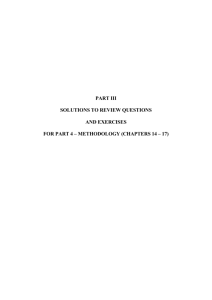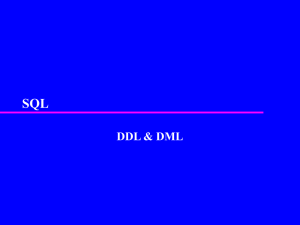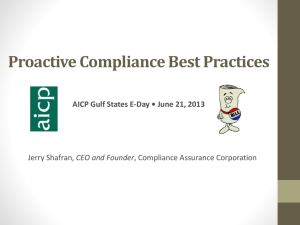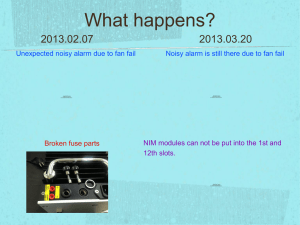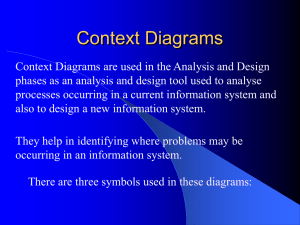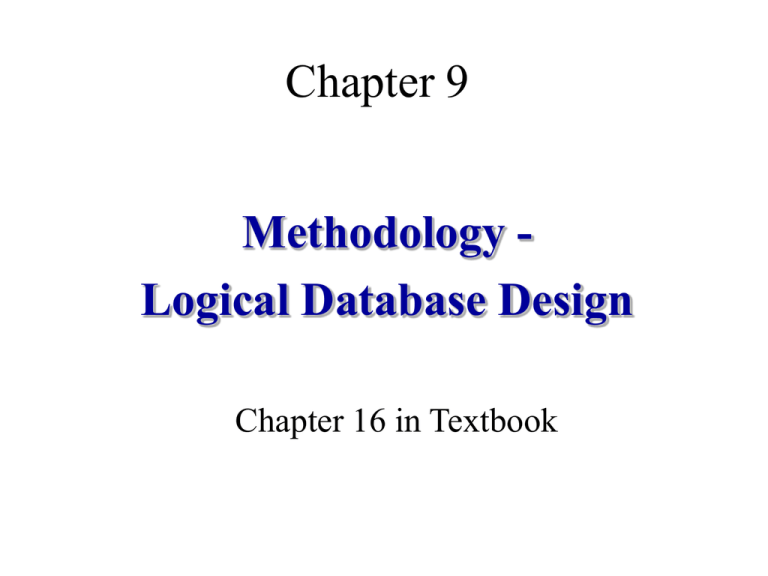
Chapter 9
Methodology Logical Database Design
Chapter 16 in Textbook
Objectives
•
Map the conceptual model into relations.
•
Validate these relations using the technique of normalization.
•
Validate a logical data model to ensure it supports required user transactions.
•
Merge local logical data models based on specific views into a global logical
data model of the enterprise.
•
Ensure that resultant global model is a true and accurate representation of
enterprise.
Logical DB Design
2
Step 2 Build and Validate
Local Logical Data Model
Step 2.1 Derive relations for local logical data model
Step 2.2 Validate relations using normalization
Step 2.3 Validate relations against user transactions
Step 2.4 Define integrity constraints
Step 2.5 Review local logical data model with user
Logical DB Design
3
Step 2.1 Derive relations for
local logical data model
Objective: To create relations for the local logical data model to represent the
entities, relationships, and attributes that have been identified.
– Strong entity types.
– Weak entity types.
– 1:1 binary relationship types.
– 1:M relationship types.
– 1:1 recursive relationship types.
– Superclass/Subclass relationship types.
– M:N relationship types.
Document relations and foreign key attributes.
Logical DB Design
4
Relations for the Staff View of
DreamHome
Staff (staffNo, FName, Lname, position, sex, DOB, SupervisorStaffNo)
Foreign Key SupervisorStaffNo
reference Staff(StaffNo)
BusinessOwner (OwnerNo, BName, Btype, ContactName, address, TelNo)
Alternate Key bName
Alternate Key TelNo
Lease (LeaseNo, PaymentMethod, depositPaid, RentStart, RentFinish, ClientNo, PropertyNo)
Alternate Key PropertyNo, RentStart
Foreign Key ClientNo refrences Client(ClientNo)
Foreign Key PropertyNo refrences Client(ClientNo)
Derived deposit (PropertForRent.rent * 2)
Derived duration (RentFinish -RentStart)
Logical DB Design
5
Step 2 Build and Validate
Local Logical Data Model
Step 2.2 Validate relations using normalization
Objective: To ensure that each relation is in at least BCNF.
Step 2.3 Validate relations against user transactions
Objective: To ensure that the relations in the local logical data
model support the transactions required by the view.
Logical DB Design
6
Step 2 Build and Validate
Local Logical Data Model
Step 2.4 Define integrity constraints
Integrity constraints protects DB from being inconsistent.
Types of integrity constraints:
– Required data.
– Entity integrity.
– Referential integrity.
– Attribute domain.
– Enterprise constraints.
Logical DB Design
7
Step 2 Build and Validate
Local Logical Data Model
In testing referential integrity check the following cases:
• Insert tuple into child relation.
• Delete tuple from child relation.
• Update FK of child tuple.
• Insert tuple into parent relation.
• Delete tuple from parent relation.
• Update PK of parent tuple.
Logical DB Design
8
Referential Integrity Constraints
for Relations
Staff (staffNo, FName, Lname, position, sex, DOB, SupervisorStaffNo)
Foreign Key SupervisorStaffNo reference Staff(StaffNo)
ON UPDATE CASCADE ON DELETE SET NULL
BusinessOwner (OwnerNo, BName, Btype, ContactName, address, TelNo)
Alternate Key bName
Alternate Key TelNo
Lease (LeaseNo, PaymentMethod, depositPaid, RentStart, RentFinish, ClientNo, PropertyNo)
Alternate Key PropertyNo, RentStart
Foreign Key ClientNo refrences Client(ClientNo)
ON UPDATE CASCADE ON DELETE NO ACTION
Foreign Key PropertyNo refrences Client(ClientNo)
ON UPDATE CASCADE ON DELETE NO ACTION
Derived deposit (PropertForRent.rent * 2)
Derived duration (RentFinish -RentStart)
Logical DB Design
9
Step 2 Build and Validate
Local Logical Data Model
Step 2.5 Review local logical data model with user
Objective: To ensure that the local logical data model and
supporting documentation that describes the model is a true
representation of the view.
Logical DB Design
10
Step 3 Build and validate
global logical data model
Combine the individual local logical data models into a single global logical data
model that represents the enterprise.
Step 3.1 Merge local logical data models into global model
Step 3.2 Validate global logical data model
Step 3.3 Check for future growth
Step 3.4 Review global logical data model with users
Logical DB Design
11
Step 3.1 Merge local logical
data models into global model
1. Review the names & contents of entities/relations and their CK.
2. Review the names & contents of relationships/FK.
3. Merge entities/relations from the local models.
4. Include (without merging) entities/relations unique to each local model.
5. Merge relationships/FK from the local models.
6. Include (without merging) relationships/FKs unique to each local model.
7. Check the missing entities/relations and relationships/FKs.
8. Check FKs.
9. Check integrity constraints.
10. Draw the global ER/relation diagram.
11. Update the documentation.
12
1. Review the names & contents of
entities/relations and their CK
Branch View
Entity Type
CK
Branch
Telephone
Staff
Manager
PrivateOwner
BusinessOwner
Client
PropertyForRent
Lease
Logical DB Design
BranchNo
PostCode
TelNo
StaffNo
StaffNo
OwnerNo
Bname
telNo
ClientNo
Propertyno
LeaseNo
PropertyNo
RentStart
ClientNo, RentStart
Staff View
Entity Type
CK
Staff
StaffNo
PrivateOwner
BusinessOwner
OwnerNo
Bname
telNo
OwnerNo
ClientNo
Propertyno
ClientNo, PropertyNo
Client
PropertyForRent
Viewing
13
2. Review the names & contents of
relationships/FK
Staff View
Branch View
Relation
FK
Relationship
Branch
mgrStaffNo -> Manager(StaffNo)
Telephone
branchN -> Branch(branchNo)
Staff
supervisorStaffNo -> Staff(staffNo)
Manager
branchNo -> Branch(branchNo)
PrivateOwner
StaffNo -> Staff(StaffNo)
FK
Relationship
Manages
Supervisor
supervisorStaffNo -> Staff(staffNo)
Supervisor
BusinessOwner
Client
PropertyForRent
Registers
OwnerNo -> PrivateOwner(ownerNo)
Owns
OwnerNo -> PrivateOwner(ownerNo)
POwns
OwnerNo ->
Owns
OwnerNo ->
BOwns
BusinessOwner(ownerNo)
Viewing
StaffNo -> Staff(StaffNo)
BusinessOwner(ownerNo)
StaffNo -> Staff(StaffNo)
Oversees
BranchNo -> Branch(BranchNo)
Offers
Logical DB Design
StaffNo -> Staff(StaffNo)
Manages
14
3. Merge entities/relations from the local
models
1. Merge entities/relations with the same name & the same PK.
Branch View
Staff View
PRIVATE OWNER(Ono, name, address)
PRIVATE OWNER(Ono, fname, lname, address)
Global View
PRIVATE OWNER(Ono, fname, lname, address)
Logical DB Design
15
3. Merge entities/relations from the local
models
2. Merge entities/relations with the same name but different PK.
Branch View
Staff View
BOWNER(bName, bType, address)
BOWNER(Ono, bName, bType, address)
AK telNo
AK bName, telNo
Global View
BOWNER(Ono, bName, bType, address)
AK bName, telNo
3. Merge entities/relations with the different names using the same or different PK.
Logical DB Design
16
4. Include (without merging) entities/relations
unique to each local model
The Previous task should identify all entities/relations that are the same.
All remaining entities/relations are included in the global model without change.
Logical DB Design
17
5. Merge relationship/FK from the local
models
1. Merge relationship/FKs with the same name & the same purpose.
2. Merge relationship/FKs with different names but the same purpose.
Logical DB Design
18
6. Include (without merging) relationships/FKs
unique to each local model
Again, the Previous task should identify all relationships/FKs that are the same.
All remaining relationships/FKs are included in the global model without change.
Logical DB Design
19
Step 3 Build and Validate
Global Logical Data Model
Step 3.2 Validate global logical data model
Objective: To validate the relations created from the global logical data
model using the technique of normalization and to ensure they support the
required transactions, if necessary.
Step 3.3 Check for future growth
Objective: To determine whether there are any significant changes likely
in the foreseeable future and to assess whether the global logical data
model can accommodate these changes.
Step 3.4 Review global logical data model with users
Objective: To ensure that the global logical data model is a true
representation of the enterprise.
Logical DB Design
20

